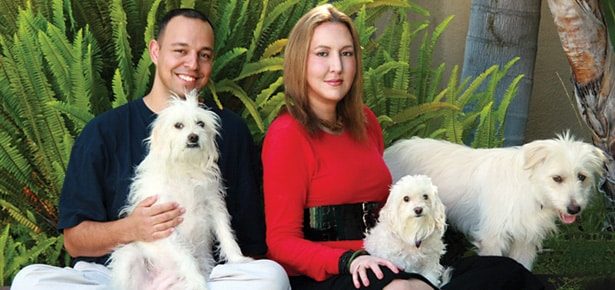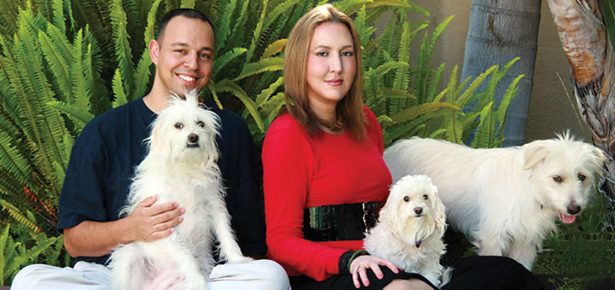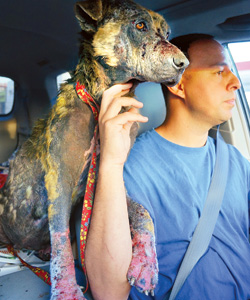

Hope for Paws
A two-person rescue team not afraid to get their hands dirty shows that it’s passion and dedication, plain and simple, that make all the difference
For Eldad Hagar, 38, and his wife, Audrey, 39, rescuing, rehabilitating, and re-homing abandoned animals from the streets and high-kill shelters is all in a (very long) day’s work.
Since 2008, Eldad and Audrey have been running Hope for Paws, their Los Angeles-based two-person non-profit animal-rescue organization, full-time. In the early years of its existence, Hope for Paws (hopeforpaws.org) attracted some loyal followers and supporters but largely operated on the streets and under the radar. But when Eldad’s three-minute, 41-second YouTube video of their resuce of a small, dirty, blind dog they named Fiona went viral last year, the number of people around the world who started paying attention to the couple’s animal-welfare efforts skyrocketed. And with good reason—theirs is precisely the sort of grassroots effort that shows that anyone duly inspired can make a monumental difference.
Here, Eldad and Audrey share some insights into their unique partnership.
MD: Eldad, knowing that you don’t have “typical” workdays, what is your schedule like?
EH: This work is all I do—sometimes it feels like 40 hours a day! The first thing I do when I wake up is look for animal-rescue requests and it’s the last thing I do before I go to sleep. Luckily, I don’t need a lot of sleep. I can be gone for a few days if I’m rescuing a dog in another state.
MD: What’s the most rewarding part of your work? And the most challenging?
EH: The most rewarding is seeing the transformation of the animals from at their worst to at their best, then finding them amazing homes. Seeing the emotional impact this process has on people is also pretty great. One thing that frustrates me is that there aren’t enough animal-rescue organizations joining forces to help save more animals and reach more people.
MD: You can get frightened dogs to come to you when others have failed. Do you think that’s because you know the right techniques or because you have a natural gift to communicate with animals?
EH: I have loved animals ever since I was a kid growing up in Israel. I’m really good at improvising during a rescue. And I’m patient. Every rescue is different because every animal is different. I’m always having to come up with new ways to capture dogs, whether it’s by using nets, humane traps, portable fences or just enticing them with a cheeseburger. I prefer rescuing dogs by myself because they’re so scared, and the more people who are there, the more likely the dogs will be to run away. It’s important for me to establish a one-on-one trusting relationship with them.
MD: How many times have you been bitten during a rescue?
EH: I can count on one hand the number of times. And I still have all of my fingers!
MD: Are you ever afraid during a rescue, and if so, of what?
EH: I have a healthy fear of animals I don’t know. When you corner an animal, whether it’s a Pit Bull or a German Shepherd or an angry scared cat, there is a risk you’ll be bitten. So I always approach cautiously. Sometimes I’m working in a rough area of L.A. where there are gangs. If I feel threatened by people? I was a soldier in the Israeli army and I can look after myself.
MD: When you and Audrey created Hope for Paws, did you imagine that your YouTube videos would one day reach people in other countries?
EH Not at all. We started out to be a local rescue organization. At first no one really knew what we were doing; it was a very quiet effort.
MD: You initially resisted using social media to promote Hope for Paws. Why?
EH: I didn’t think I’d have time to manage it. But a friend encouraged me to join Facebook, and it has changed my life. Because of social media, we’re able to reach people all over the world with our YouTube videos. This helps teach others how to rescue and properly care for animals. I want to teach the public not just how to rescue animals but also how to not abandon them in the first place.
MD: Do you think the day will ever come when your rescue services will no longer be needed because people will have stopped abandoning animals?
EH: I hate to say probably not. The best I can hope for is that we are minimizing the problem. I have seen improvements in L.A. and in other countries in recent years where fewer animals are being abandoned, and that’s a positive step. So things are definitely getting better.
MD: Can you see yourself crawling under cars and climbing into ditches to rescue dogs when you’re 60 or 70?
EH: I’m hoping I’ll be doing this well into my 90s! I wake up every morning looking forward to the day ahead. Some of the rescue work is physical, but a lot of it is not. It’s having the patience and the time to establish a relationship with an animal so it will trust you enough to come to you.
MD: What message would you like to send Modern Dog readers about adopting shelter animals?
EH: That there is no reason to buy a puppy from a breeder when there are millions of adoptable dogs being euthanized in shelters every year. With a little effort, you can find every breed at shelters, or you can look for a breed-specific rescue group. The key is hope—it’s what I really want to give people through Hope for Paws, the inspiration for others to join in this effort, whether it’s donating $5 or giving a shelter dog a bath. It doesn’t have to take much time or money, but it can help change an animal’s life.
MD: Audrey, when you married Eldad in 1999, did you have any idea how big a role animal rescue would become in your lives?
AH: Absolutely not! My grandfather Joseph, who died last year, knew that Eldad and I both loved animals and suggested that we should do some sort of work with them. So we began volunteering for some rescue groups. We started out walking dogs that were being boarded at the vet clinic. We learned most of what we know about the work we’re doing now during those eight years of volunteering before we launched Hope for Paws.
MD: Eldad has said that he couldn’t do what he does without your support. He sometimes misses social events to perform an urgent rescue mission. Is that challenging?
AH: No, because if there’s a dog lying hurt and bleeding on the freeway, of course I’m going to say go and get it, regardless of what plans we might have made. What I don’t like is the danger aspect of some of Eldad’s rescues, especially when he goes to a rough neighbourhood to rescue a Pit Bull in the middle of the night. I sometimes wonder, at what point am I supposed to call the police? But he was a well-trained solider in the Israeli army, he’s tough and quick on his feet, and he applies that to his rescue work. So I feel some security because of that.
MD: You occasionally appear in the YouTube rescue videos, and you answer Facebook questions and Hope for Paws emails. What other roles do you perform?
AH: I handle a lot of administration, including issuing tax receipts to donors and overseeing our non-profit board, accountant, and attorney. And I try to respond to every email. But it’s just Eldad and me—we don’t have a support staff—so it can be difficult at times to keep up with the volume.
MD: How important are public donations to Hope for Paws?
AH: Very important. We pay for rescued strays that are broken and suffering. They’ve all been out in the elements for a long time. Most are starving and dehydrated. Some have been hit by cars and have broken bones. They may have mange, parasites, fleas, ticks, and infections. Many need immediate emergency care or they’ll suffer a horrible death. We’ve paid for surgeries for many dogs and cats—even for some horses. Hope for Paws’ medical bills are astronomical. So that’s where a lot of our donations go.
MD: How many animals of your own do you and Eldad have?
AH: We have three dogs, Dolly, Heidi and Chase, and two cats, Cosmo and Brooke. Dolly came from the pound. Heidi was tossed in someone’s yard and brought in a box to the pound. Chase was a Hope for Paws rescue. Cosmo was rescued by our vet tech. Brooke was a feral kitten Eldad rescued after my 11-year-old cousin heard a noise and called Eldad, who found her in a neighbour’s sewer pipe.
MD: Do you believe that teaching young people how to treat animals is key to reducing the number of abandoned animals in the future?
AH: It’s the most important thing we can do. Eldad and I have gone into classrooms and explained to the kids that animals have feelings and are family members. We tell them if your grandmother is sick, you would take her to the hospital, and that you have to do the same for your dog or cat. It’s one thing to make animal-cruelty laws, but just because a law is in place doesn’t mean people are going to abide by it. It has a bigger impact when we can help kids make an emotional connection to animals; the hope is that when they grow up, they won’t mistreat them.
Go! Find out more at hopeforpaws.org and eldadhagar.com.
Join the newsletter and never miss out on dog content again!
"*" indicates required fields
By clicking the arrow, you agree to our web Terms of Use and Privacy & Cookie Policy. Easy unsubscribe links are provided in every email.
